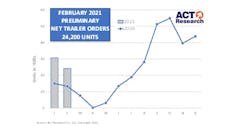Record freight rates continue to push commercial vehicle demand beyond truck and trailer manufacturers’ ability to supply equipment in a timely manner, suggest a series of recent reports from ACT Research.
Preliminary reports indicate that February's net order volume of 24.2k trailers was up 82% from the same month last year, according to ACT Research’s State of the Industry: U.S. Trailers report. That was also down 21% from January 2021 bookings. Final February volume will be available later this month, the research firm noted.
“Given last year’s COVID-related softer economy, year-over-year improvement for net orders is a foregone conclusion over the next few months. February’s sequential decline in net orders was a bit larger than seasonal patterns would project, but was directionally correct,” Frank Maly, director, CV Transportation Analysis and Research at ACT Research, said. “Preliminary results for the month still show that the industry backlog continued to grow in February, reaching the highest point since March 2019. With many OEMs reporting their capacity committed for the year, there may be some reluctance to push the backlog horizon out even further, on both the part of OEMs and fleets.”
The backlog horizon will be pulled forward in response to higher OEM build rates, he suggested, but the February preliminary orders indicate that goal remains “elusive,” with minimal increases in production rates last month.
“Our discussions indicate that staffing remains the primary headwind impeding higher production, with component and material supplies also noted as concerns,” Maly said. “Fleets want to add more trailers to their operations but would certainly like more advantageous delivery timeframes.”
Likewise, according to ACT’s latest release of the North American Commercial Vehicle OUTLOOK, the supply chain’s ability to respond to demand will be the key determinant of Class 8 and van trailer production in 2021.
“With orders remaining hot through preliminary February reporting from ACT, backlogs and backlog-to-build ratios continuing to rise, as well as new vehicle inventories tightening, the problem isn’t demand, but supply,” ACT President and Senior Analyst Kenny Vieth said. “To no small extent, it appears that the more traditional early-cycle ramping pains, like tires, assorted cast parts, and wiring harnesses, are taking a backseat to more cycle-specific constraints, which begin with the simultaneous global ramp in economic activity overlaid with pandemic-specific challenges.
“Demand is so strong for Class 8 and trailers that 2021 build slots are rapidly selling out. In addition, and despite a strong backlog for the Classes 5-7 segment, there is a very real consideration that medium duty output may be deprioritized in favor of demand for Class 8 vehicles, as OEMs grapple with supply chain constraints.”
Indeed, the latest installment of the ACT Freight Forecast, U.S. Rate and Volume OUTLOOK report indicates a strong freight market is driving CV order activity.
“Pushing commercial vehicle demand forward, freight rates ended February at record levels, seasonally adjusted, and started March on an upswing,” Tim Denoyer, ACT Research vice president and senior analyst said. “With the nation’s ports backed up for months, commodity prices soaring, the manufacturing sector warming up, and the housing market already in full swing, there is unparalleled visibility to strong freight flows.”
Regarding the truckload spot rate market, Denoyer sees more increases on the horizon, as the latest federal COVID-19 relief package will add to both freight demand and to the challenges of “re-engaging supply”—which presses the ACT Research spot rate forecasts higher this month.
ACT Research’s State of the Industry: U.S. Trailers report provides a monthly review of the current US trailer market statistics, as well as trailer OEM build plans and market indicators divided by all major trailer types, including backlogs, build, inventory, new orders, cancellations, net orders, and factory shipments.
The N.A. CV OUTLOOK forecasts the future of the industry, looking at the next 1-5 years, with the objective of giving OEMs, Tier 1 and Tier 2 suppliers, and investment firms the information needed to plan accordingly for what is to come.









